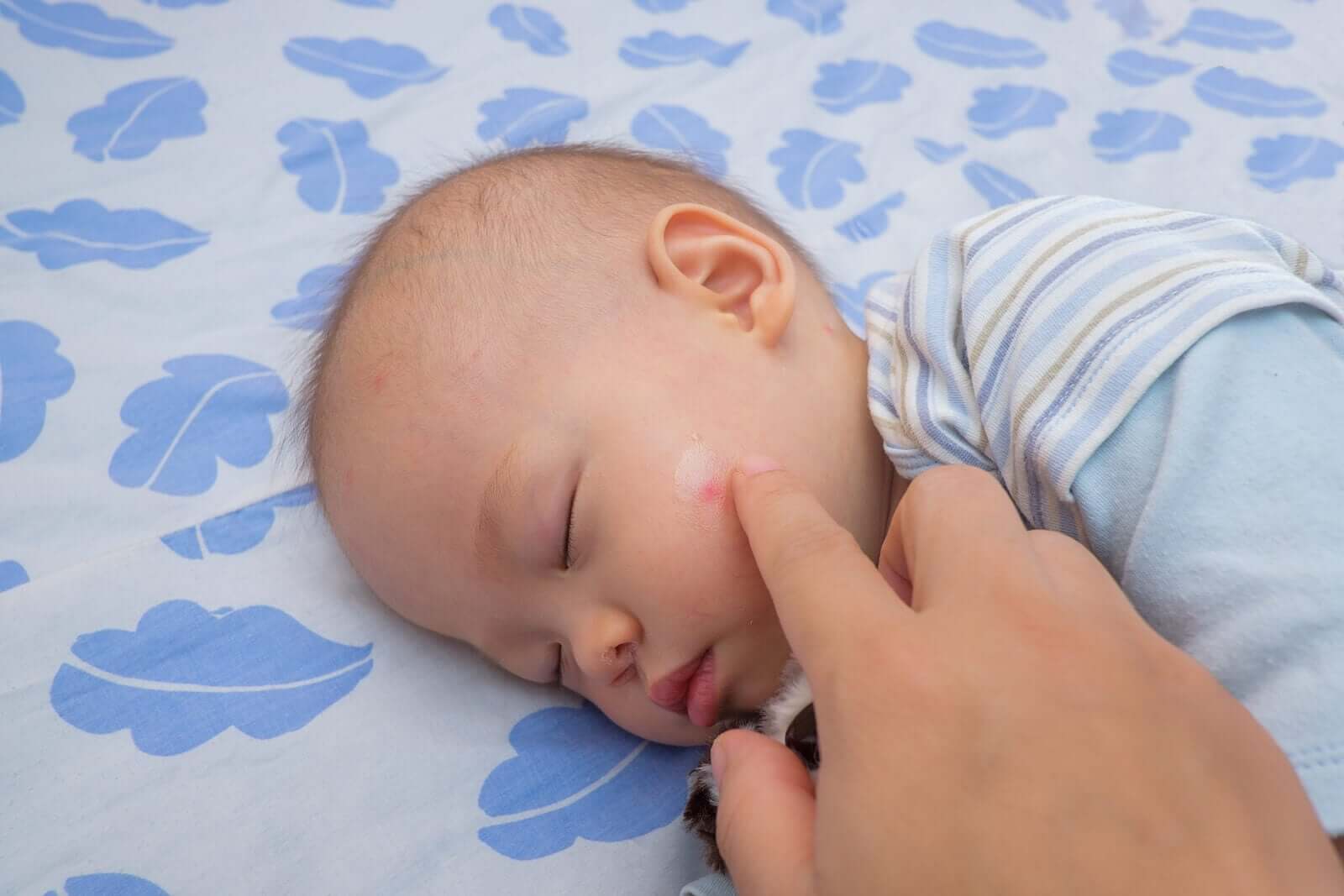Allergies to Bites and Stings in Infants and Children


Written and verified by the dermatologist Maria del Carmen Hernandez
Allergies to bites and stings is a common and unwanted occurrence for many parents. Although for most infants and children they’re only a mild and common discomfort, in certain cases, children may experience exaggerated or severe responses.
What bugs can bite or sting?
When we talk about bugs that bite or sting, we’re talking about members of the arthropod family. In that sense, there are four classes of arthropods with great medical importance:
- Kelopods: Centipedes.
- Diplopods: Millipedes.
- Insects: Hymenoptera (fire ants, hornets, wasps, bees), bugs, fleas, mosquitoes, moths and caterpillars, beetles, and lice.
- Arachnids: Ticks, scorpions, mites, and spiders.

You may be interested: Wasp Stings: Prevention and Treatment
Clinical manifestations of allergies to bites and stings in infants and children
Allergic reactions to antigens in the saliva of arthropods are common and favor the production of localized or generalized skin itching and rashes. While arthropods can release toxic substances, what’s more concerning is the potential for transmitting relevant diseases:
- Ticks: Lyme disease, recurrent fever, anaplasmosis, Rocky Mountain spotted fever, babesia, tularemia.
- Flies: Leishmaniasis, tularemia, African trypanosomiasis, loiasis, bartonellosis
- Fleas: Murine typhus, tularemia, plague.
- Body lice: Epidemic typhus, recurrent fever.
- Mosquitoes: Malaria, dengue, yellow fever, West Nile virus, chikungunya, Zika virus, equine encephalitis.
Anaphylactic reaction
The most important allergic response to bites and stings from external agents is the development of anaphylaxis, which can be fatal very quickly. With that in mind, the signs that a child or infant with anaphylaxis may have are:
- Coughing, choking or wheezing
- Difficulty swallowing or breathing
- Fainting
- Paleness or limpness
- Edema of the tongue or lips
- Hoarse voice and difficulty speaking
- Hives or intense itching
In any of these situations, you must request an ambulance urgently. Even if the site of the injury is infected or red, hot and painful, you may require antibiotics from your doctor.
Recommendations for preventing allergies to bites and stings
The most important step in reducing the impact of bites and stings on children and babies is to prevent them from occurring.
Repellents
According to publications by The Medical Clinics of North America, DEET (N, N-diethyl-meta-toluamide) is the best-studied and most effective broad-spectrum repellent against biting arthropods.
A very effective repellent contains between 20% to 30% DEET (N,N-diethyl-m-toluamide). Consequently, DEET in high concentrations (more than 30%) can cause side effects, particularly in children.
Therefore, the Argentinean Pediatric Society recommends that repellents used on children shouldn’t contain more than 30% DEET. In fact, it doesn’t even recommend insect repellents for infants under 2 months of age. Alternatives to DEET include picaridin and PMD (P-menthane-3,8-diol).
Appropriate clothing
Children should use appropriate clothing, such as long-sleeved shirts and light-colored pants and hats. Doing so tends to reduce the chances of suffering from insect bites and contracting vector-borne diseases.
The application of permethrin to clothing greatly enhances the deterrence of insect bites, even when you spray it on bed nets or rooms at bedtime.
Read also: Jellyfish Stings in Children: What You Need to Know
What to do about bites and stings in babies and children?
The damage that bites and stings do to the body is due to several processes that are involved, which are interrelated. That is, mechanical injury to the skin during the bite causes swelling and pain. In turn, this injury provides a doorway for different bacteria to enter and trigger a secondary infection.

In most cases, you can treat bites and stings at home without requiring a visit to the emergency room. Some of the support and hygiene measures are the following:
- Wash the wound area with soap and water. Also, if a sting is left or the tick remains attached, it should be removed.
- Treat the pain with analgesics.
- Avoid scratching the area. To cope with this situation, oral antihistamines can be used; use creams with calamine or corticosteroids of medium strength. At the same time, applying ice locally is also useful and will help reduce inflammation.
- Remember, some lesions can be superinfected. In these cases, the skin becomes warmer, red and painful and develops an infectious cellulitis, which will require a prescription for oral antibiotics from your doctor.
Regarding allergies and stings in infants and children…
In conclusion, bites in children and babies are a very common occurrence in which local treatment and symptom management are usually sufficient. In turn, the size of the allergic reaction in the sting is greater in early childhood and then decreases as the child grows. However, the size of the reaction depends on the degree of allergy that the child has.
Allergies to bites and stings is a common and unwanted occurrence for many parents. Although for most infants and children they’re only a mild and common discomfort, in certain cases, children may experience exaggerated or severe responses.
What bugs can bite or sting?
When we talk about bugs that bite or sting, we’re talking about members of the arthropod family. In that sense, there are four classes of arthropods with great medical importance:
- Kelopods: Centipedes.
- Diplopods: Millipedes.
- Insects: Hymenoptera (fire ants, hornets, wasps, bees), bugs, fleas, mosquitoes, moths and caterpillars, beetles, and lice.
- Arachnids: Ticks, scorpions, mites, and spiders.

You may be interested: Wasp Stings: Prevention and Treatment
Clinical manifestations of allergies to bites and stings in infants and children
Allergic reactions to antigens in the saliva of arthropods are common and favor the production of localized or generalized skin itching and rashes. While arthropods can release toxic substances, what’s more concerning is the potential for transmitting relevant diseases:
- Ticks: Lyme disease, recurrent fever, anaplasmosis, Rocky Mountain spotted fever, babesia, tularemia.
- Flies: Leishmaniasis, tularemia, African trypanosomiasis, loiasis, bartonellosis
- Fleas: Murine typhus, tularemia, plague.
- Body lice: Epidemic typhus, recurrent fever.
- Mosquitoes: Malaria, dengue, yellow fever, West Nile virus, chikungunya, Zika virus, equine encephalitis.
Anaphylactic reaction
The most important allergic response to bites and stings from external agents is the development of anaphylaxis, which can be fatal very quickly. With that in mind, the signs that a child or infant with anaphylaxis may have are:
- Coughing, choking or wheezing
- Difficulty swallowing or breathing
- Fainting
- Paleness or limpness
- Edema of the tongue or lips
- Hoarse voice and difficulty speaking
- Hives or intense itching
In any of these situations, you must request an ambulance urgently. Even if the site of the injury is infected or red, hot and painful, you may require antibiotics from your doctor.
Recommendations for preventing allergies to bites and stings
The most important step in reducing the impact of bites and stings on children and babies is to prevent them from occurring.
Repellents
According to publications by The Medical Clinics of North America, DEET (N, N-diethyl-meta-toluamide) is the best-studied and most effective broad-spectrum repellent against biting arthropods.
A very effective repellent contains between 20% to 30% DEET (N,N-diethyl-m-toluamide). Consequently, DEET in high concentrations (more than 30%) can cause side effects, particularly in children.
Therefore, the Argentinean Pediatric Society recommends that repellents used on children shouldn’t contain more than 30% DEET. In fact, it doesn’t even recommend insect repellents for infants under 2 months of age. Alternatives to DEET include picaridin and PMD (P-menthane-3,8-diol).
Appropriate clothing
Children should use appropriate clothing, such as long-sleeved shirts and light-colored pants and hats. Doing so tends to reduce the chances of suffering from insect bites and contracting vector-borne diseases.
The application of permethrin to clothing greatly enhances the deterrence of insect bites, even when you spray it on bed nets or rooms at bedtime.
Read also: Jellyfish Stings in Children: What You Need to Know
What to do about bites and stings in babies and children?
The damage that bites and stings do to the body is due to several processes that are involved, which are interrelated. That is, mechanical injury to the skin during the bite causes swelling and pain. In turn, this injury provides a doorway for different bacteria to enter and trigger a secondary infection.

In most cases, you can treat bites and stings at home without requiring a visit to the emergency room. Some of the support and hygiene measures are the following:
- Wash the wound area with soap and water. Also, if a sting is left or the tick remains attached, it should be removed.
- Treat the pain with analgesics.
- Avoid scratching the area. To cope with this situation, oral antihistamines can be used; use creams with calamine or corticosteroids of medium strength. At the same time, applying ice locally is also useful and will help reduce inflammation.
- Remember, some lesions can be superinfected. In these cases, the skin becomes warmer, red and painful and develops an infectious cellulitis, which will require a prescription for oral antibiotics from your doctor.
Regarding allergies and stings in infants and children…
In conclusion, bites in children and babies are a very common occurrence in which local treatment and symptom management are usually sufficient. In turn, the size of the allergic reaction in the sting is greater in early childhood and then decreases as the child grows. However, the size of the reaction depends on the degree of allergy that the child has.
All cited sources were thoroughly reviewed by our team to ensure their quality, reliability, currency, and validity. The bibliography of this article was considered reliable and of academic or scientific accuracy.
- Tan JW, Campbell DE. Insect allergy in children. J Paediatr Child Health. 2013 Sep;49(9):E381-7. doi: 10.1111/jpc.12178. Epub 2013 Apr 16. PMID: 23586469.
- Steen CJ, Carbonaro PA, Schwartz RA. Arthropods in dermatology. J Am Acad Dermatol. 2004 Jun;50(6):819-42, quiz 842-4. doi: 10.1016/j.jaad.2003.12.019. PMID: 15153881.
- Alpern JD, Dunlop SJ, Dolan BJ, Stauffer WM, Boulware DR. Personal Protection Measures Against Mosquitoes, Ticks, and Other Arthropods. Med Clin North Am. 2016 Mar;100(2):303-16. doi: 10.1016/j.mcna.2015.08.019. PMID: 26900115.
This text is provided for informational purposes only and does not replace consultation with a professional. If in doubt, consult your specialist.








